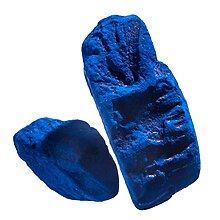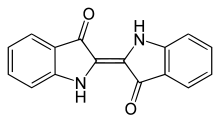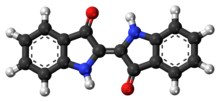
Back صبغة النيلة Arabic رنق نیل AZB Індыга Byelorussian Индиго Bulgarian Indigo BS Indi (colorant) Catalan Indigo Czech Indigo (farvestof) Danish Indigo German Indigo (farbo) Esperanto
 | |
 | |
 | |
| Names | |
|---|---|
| Preferred IUPAC name
[2(2')E]-[2,2'-Biindolylidene]-3,3'(1H,1'H)-dione | |
| Other names
2,2'-Bis(2,3-dihydro-3-oxoindolyliden), Indigotin
| |
| Identifiers | |
3D model (JSmol)
|
|
| ChEMBL | |
| ChemSpider | |
| ECHA InfoCard | 100.006.898 |
PubChem CID
|
|
| RTECS number |
|
| UNII | |
CompTox Dashboard (EPA)
|
|
| |
| |
| Properties | |
| C16H10N2O2 | |
| Molar mass | 262.27 g/mol |
| Appearance | dark blue crystalline powder |
| Density | 1.199 g/cm3 |
| Melting point | 390 to 392 °C (734 to 738 °F; 663 to 665 K) |
| Boiling point | decomposes |
| 990 µg/L (at 25 °C) | |
| Related compounds | |
Related compounds
|
Indoxyl Tyrian purple Indican |
Except where otherwise noted, data are given for materials in their standard state (at 25 °C [77 °F], 100 kPa).
| |
Indigo dye is an organic compound with a distinctive blue color. Indigo is a natural dye extracted from the leaves of some plants of the Indigofera genus, in particular Indigofera tinctoria. Dye-bearing Indigofera plants were commonly grown and used throughout the world, particularly in Asia, with the production of indigo dyestuff economically important due to the historical rarity of other blue dyestuffs.[1]
Most indigo dye produced today is synthetic, constituting around 80,000 tonnes each year, as of 2023.[2] It is most commonly associated with the production of denim cloth and blue jeans, where its properties allow for effects such as stone washing and acid washing to be applied quickly.
- ^ Cite error: The named reference
Ullmannwas invoked but never defined (see the help page). - ^ Linke, Julia A.; Rayat, Andrea; Ward, John M. (2023). "Production of indigo by recombinant bacteria". Bioresources and Bioprocessing. 10 (1): 20. doi:10.1186/s40643-023-00626-7. ISSN 2197-4365. PMC 10011309. PMID 36936720.